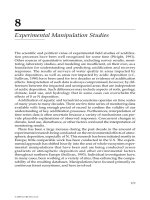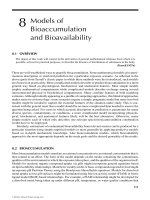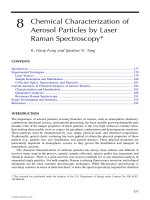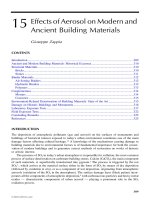CONCRETE IN HOT ENVIRONMENTS - CHAPTER 8 pot
Bạn đang xem bản rút gọn của tài liệu. Xem và tải ngay bản đầy đủ của tài liệu tại đây (167.8 KB, 15 trang )
Chapter 8
Creep
8.1. INTRODUCTION
Creep may be defined as the increase in deformation with time, excluding
shrinkage, under a sustained stress. Such a deformation occurs in metals at
elevated temperatures but in concrete it takes place at room temperatures as
well. Hence, the importance of the creep behaviour in daily practice.
In the following discussion a distinction is not always made between cement
paste and concrete. Creep behaviour of concrete is essentially similar to that
of the paste because the aggregate hardly exhibits any creep. Hence, in
discussing creep qualitatively, paste and concrete are interchangeable. On the
other hand, aggregate properties and concentration affect creep quantitatively,
and in this context there is a significant difference between creep of the cement
paste and that of concrete. This aspect, however, is dealt with later in the text
(see section 8.4.2.1).
Finally, creep is usually measured by the length changes involved and is
expressed quantitatively by the corresponding strains, ⌬1/1
0
, or by the
corresponding strains per unit stress. The latter is known as ‘specific creep’
(see section 8.4.2.2).
Copyright 1993 E & FN Spon
8.2. THE PHENOMENA
On loading concrete undergoes an instantaneous deformation which is
generally regarded as elastic, i.e. a deformation which appears and disappears
completely immediately on application and removal of the load, respectively.
If the load is sustained, the deformation increases, at a gradually decreasing
rate, and may reach a value which is two to three times greater than the elastic
deformation. If the concrete is allowed to dry when under load, shrinkage
occurs simultaneously. Accordingly, creep is the increase in deformation with
time under a sustained load excluding drying shrinkage. This is demonstrated
in Fig. 8.1 for a concrete loaded in compression. It may be noted that the
elastic deformation, contrary to creep and shrinkage, decreases with time. This
is due to the increase in the modulus of elasticity which is associated with the
increase in concrete strength.
Generally, the simultaneous drying of concrete is associated with increased
creep (see section 8.4.1). Hence, a distinction is sometimes made between
‘basic creep’ and ‘drying creep’. Basic creep is the creep which takes place
when the concrete is in hygral equilibrium with its surroundings and,
consequently, no simultaneous drying is involved. Accordingly, drying creep is
the additional creep which is brought about by the simultaneous drying (Fig.
8.1). In most engineering applications the distinction between basic and drying
creep is not important, and the term ‘creep’ usually refers to total creep, i.e.
to the sum of basic and drying creep.
Similarly to shrinkage, creep is partly irrecoverable. On unloading, the
strain decreases immediately due to elastic recovery. The instantaneous
Fig. 8.1. Schematic description of the deformation with time of concrete under
sustained compressive load and undergoing a simultaneous drying shrinkage.
Copyright 1993 E & FN Spon
recovery is followed by a gradual decrease in strain which is known as ‘creep
recovery’. Creep recovery is not complete, approaching a limiting value with
time. The remaining residual strain is the ‘irreversible creep’ (Fig. 8.2).
8.3. CREEP MECHANISMS
A few mechanisms have been suggested to explain creep of the cement paste
and some of them are briefly presented here. It will be seen later that both
creep and shrinkage are essentially affected the same way by the same factors
and, indeed, to some extent, the two may be looked upon as similar
phenomena. Consequently, some of the mechanisms which have been
suggested to explain creep are actually an extension of the same mechanisms
which have been suggested to explain shrinkage.
8.3.1. Swelling Pressure
In a previous discussion (see section 7.3.3), volume changes in the cement
paste, due to variations in its moisture content, were attributed to variations
in the swelling pressure brought about by variations in ambient relative
humidity. It has been suggested that the same mechanism, induced by
external loading, rather than the ambient humidity, may explain the
reversible part of creep [8.1, 8.2]. That is, due to external loading some of
the water between adjacent gel particles, i.e. some of the load-bearing water
Fig. 8.2. Schematic description of creep and creep recovery in concrete in hygral
equilibrium with its surroundings.
Copyright 1993 E & FN Spon
in areas of hindered adsorption (Chapter 7, Fig. 7.3), is squeezed out into
bigger pores (areas of unhindered absorption) by a time-dependent diffusion
process. Consequently, the swelling pressure gradually decreases, the spacing
between the gel particles is reduced and the volume of the paste is thereby
decreased, i.e. creep takes place. When the paste is unloaded, the pressure on
the load-bearing water is relieved, and a reversed process takes place. That
is, the water gradually diffuses back from the areas of unhindered
absorption, and the swelling pressure gradually increases to the level
determined by the ambient relative humidity. This resulting increase in the
swelling pressure causes a volume increase, i.e. creep recovery is taking
place.
8.3.2. Stress Redistribution
On application, the external load is distributed between the liquid and the
solid phases of the concrete. Under sustained loading the compressed water
diffuses from high to low pressure areas and, consequently, a gradual transfer
of the load from the water to the solid phase takes place. Hence, the stress in
the solid gradually increases causing, in turn, a gradual volume decrease, i.e.
creep. That is, creep may be regarded as a delayed elastic deformation [8.3,
8.4]. Accordingly, a lower creep is to be expected in a stronger concrete
because such a concrete has a higher modulus of elasticity. Similarly, a higher
creep is to be expected at a higher moisture content, because the higher the
moisture content the greater the part of the load which is initially taken by the
water and later transferred to the solid. Again, in accordance with this
mechanism, creep is expected to increase with temperature due to the effect of
the latter on the viscosity of the water.
8.3.3. Movement of Interlayer Water
The movement of interlayer water, in and out of the laminated structure of
the gel particles, was suggested to explain shrinkage and swelling of the
cement paste (see section 7.3.4). Similarly, it has been suggested that creep
is attributable to the same mechanism in which the exit of the interlayer
water is brought about by the imposed external load, and not by the
decrease in ambient humidity [8.5]. The exit of the interlayer water reduces
the spacing between the layers, and thereby causes volume decrease, i.e.
Copyright 1993 E & FN Spon
creep. On unloading, some of the water re-enters the structure, the spacing
between the layers is increased and some of the creep is recovered. It should
be pointed out, however, that in a later study it was concluded that this
mechanism of water movement, although it occurs, is not the major
mechanism involved [8.6].
8.3.4. Concluding Remarks
The three preceding mechanisms differ considerably, but all three attribute
creep, in one way or another, to movement of water within the cement paste.
In this respect, it may be noted that shrinkage is also attributable to movement
of water. However, whereas in the case of creep, the movement of the water
takes place within the paste, in the case of shrinkage the moisture exchange
takes place between the paste and its surroundings.
Other mechanisms have been suggested to explain creep [8.7].
Nevertheless, it seems that the creep mechanism is not fully understood, and
the suggested mechanisms do not always account for some of the creep
aspects. For example, considering the preceding mechanisms, all three
predict that no creep is to be expected in a saturated or in a completely dried
paste. This is, however, not necessarily the case (see section 8.4.2.3).
8.4. FACTORS AFFECTING CREEP
8.4.1. Environmental Factors
It was pointed out earlier that the simultaneous drying of concrete increases
creep, and that this increase is referred to as drying creep. Hence, it is to be
expected that all factors which affect drying and induce shrinkage will
similarly affect creep. It is further to be expected that creep will increase with
the intensity of drying conditions, i.e. with the decrease in ambient humidity
and the increase in temperature and wind velocity.
The effect of simultaneous drying (i.e. shrinkage) on creep is demonstrated
in Fig. 8.3, and it is clearly evident that a more intensive drying (i.e. lower
ambient relative humidity) brings about greater creep. This effect has been
confirmed in many tests and is reflected, for example, in estimating creep with
respect to ambient relative humidity in accordance with British Standard BS
8110, Part 2, 1985 (Fig. 8.4). Furthermore, it was suggested that, accordingly,
Copyright 1993 E & FN Spon
the relation between total creep, C, and simultaneous shrinkage, S
s
, may be
expressed by the following expression [8.9]:
C=C
b
(1+kS
s
)
in which C
b
is the basic creep, S
s
is the simultaneous shrinkage at the conditions
considered and k is a constant which depends on concrete properties.
Considering that temperature affects the rate of drying, and thereby shrinkage,
it is to be expected that creep also will increase with the rise in temperature.
Moreover, noting that creep is associated with water movement within the
cement, and that the viscosity of the water decreases with temperature, it is to be
expected, again, that creep will increase with the rise in temperature.
Fig. 8.3. Effect of simultaneous drying on creep of concrete moist cured for 28
days and then loaded and exposed to the relative humidities indicated. (Adapted
from Ref. 8.8.)
(8.1)
Fig. 8.4. Effects of relative humidity, age of loading and section thickness upon
the creep factor. (Adapted from BS 8110, Part 2, 1985.)
Copyright 1993 E & FN Spon
It can be seen from Fig. 8.5 that, indeed, creep increases with temperature.
This increase, however, takes place up to the temperature of, say 60°C, but a
further increase in temperature brings about a reversed trend. Such a reversed
trend, at approximately 70°C, has been observed by others [8.11], and can be
attributed to the two opposing effects of temperature. As already pointed out,
the decreased viscosity of water is expected to increase creep. On the other
hand, as will be seen later (see section 8.4.2.2), creep is strength related and,
under otherwise the same conditions, a lower creep is to be expected in a
stronger concrete. That is, as the rise in temperature accelerates hydration and
thereby strength development, creep is expected to decrease with temperature.
Apparently, the effect of the increased strength on creep, in the lower
temperature range, is less than the effect of the decreased water viscosity.
Hence, the increase in creep in the lower temperature range. In the higher
range, however, the net effect of the two opposing effects is reversed, and
creep decreases with a rise in temperature. It must be realised that in hot
environments this reversed trend is of no practical importance because
temperatures exceeding 60–70°C do not occur even under severe climatic
conditions. Hence, even under such conditions, temperature may be
considered to increase creep.
It was shown above that early and short exposure of fresh concrete to
intensive drying increases strength (Chapter 6, Fig. 6.15) and reduces
shrinkage (Chapter 7, Fig. 7.7). As both strength and shrinkage affect creep,
it is to be expected that the same exposure will similarly affect creep, i.e. creep
will be reduced when similarly exposed. This expected behaviour is confirmed
by the data presented in Fig. 8.6 and supported by the data of some others
[8.14]. It must be stressed again, however, that this apparent beneficial effect
should not be considered as a possible recommendation to expose fresh
concrete to early and intensive drying. From reasons elaborated earlier, such
an exposure must definitely be avoided and the fresh concrete must be
protected from drying as early as possible.
Fig. 8.5. Effect of ambient tem-
perature on basic creep of cement
paste loaded for 6 days at the age
of 28 days. Applied stress 0·1 MP
a
.
(Adapted from Ref. 8.10.)
Copyright 1993 E & FN Spon
8.4.2. Concrete Composition and Properties
8.4.2.1. Aggregate Concentration and Rigidity
The aggregates normally used in concrete production do not creep, and the
creep of concrete is determined, therefore, by the creep of the cement paste
and its relative content in the concrete. It follows that a higher creep is to be
expected in cement-rich concrete or, alternatively, creep is expected to increase
with the decrease in aggregate concentration. This latter conclusion is
confirmed by the data of Fig. 8.7.
As normal aggregates do not creep, their presence in the concrete restrains
the creep of the paste to an extent which depends on their rigidity. Hence, for
otherwise the same conditions, concretes made of soft aggregates are expected
Fig. 8.6. Effect of early exposure, at the temperatures and relative humidities
indicated (wind velocity 20 km/h), on specific creep of concrete at the age of
425 days. Concrete containing 350 kg/m
3
ordinary Portland cement (OPC)
loaded at the age of 60 days and kept at 20°C and 65% RH. (Adapted from
Refs 8.12 and 8.13.)
Fig. 8.7. Effect of aggregate concentra-
tion on creep of concrete loaded for 60
days at the age of 14 days. (Adapted
from Ref. 8.15.)
Copyright 1993 E & FN Spon
to exhibit higher creep than those made with hard aggregates. Lightweight
aggregate is softer than normal-weight aggregate. Hence, it follows that creep
of lightweight aggregate concrete will be higher than that of normal weight
aggregate concrete. This conclusion is confirmed by the data of Fig. 8.8.
The data of Fig. 8.8 compare creep of concretes made with the same water
to cement (W/C) ratio. On the other hand, when concretes of the same
strength are compared, essentially the same creep is observed (Fig. 8.9). The
strength of lightweight aggregate concrete is lower than the strength of
Fig. 8.8. Creep of concretes of different W/C ratios made with lightweight and
normal-weight aggregates. (1) Air-entrained lightweight aggregate concrete, (2)
as (1) but with no air entrainment, (3) normal-weight concrete. (Adapted from
Ref. 8.16.)
Fig. 8.9. Creep of concretes of dif-
ferent strengths made with lightweight
and normal-weight aggregates.
(Adapted from Ref. 8.16.)
Copyright 1993 E & FN Spon
normal-weight concrete of the same W/C ratio (Chapter 6, Fig. 6.6) and, in
order to obtain the same strength, the former concrete must be prepared with
a lower W/C ratio than the latter one. The lower W/C ratio reduces the creep
of the cement paste (see section 8.4.2.2), and this reduction counteracts the
increased creep which is brought about by the use of the softer lightweight
aggregate. Hence, essentially the same creep is exhibited by lightweight and
normal-weight aggregate concretes of the same strength.
In view of the preceding discussion, it is evident that the effect of aggregate
concentration and rigidity on creep must be similar to their effect on
shrinkage. Indeed, creep of concrete can be expressed by the following
equation, which is analogous to the one expressing shrinkage (see eqn (7.1)):
C=C
p
(l-V
a
)
n
in which C and C
p
are the creep of concrete and paste, respectively; V
a
is the
volume fraction of the aggregate, and n is a factor which depends on the
elastic properties of the aggregate.
8.4.2.2. Strength, Stress and Stress to Strength Ratio
It is implied by the suggested creep mechanisms (see section 8.3), that
creep must decrease with the increase in concrete modulus of elasticity
and the increase in the stress level induced by the external load. The
effect of modulus of elasticity and that of the stress level are self-evident
once creep is considered as a delayed elastic deformation (see section
8.3.2). The modulus of elasticity is strength related, whereas strength is
determined by the W/C ratio. Accordingly, Figs 8.8 and 8.10 indicate
that, indeed, creep depends on the W/C ratio or, alternatively, on strength
Fig. 8.10. Effect of W/C ratio on basic creep of cement paste after 6 days of
loading. Applied stress 0·1 MP
a
. (Adapted from Ref. 8.10.)
(8.2)
Copyright 1993 E & FN Spon
(Fig. 8.9). Similarly, the expected effect of the stress level is demonstrated
in Fig. 8.11.
Noting that creep increases with the stress level and decreases with
strength, it is to be expected that creep will increase with an increase in the
stress to strength ratio. The data of Fig. 8.12 confirm this conclusion, and
indicate that a linear relation between creep and stress to strength ratio exists
up to the ratio of 0·85. Other values have been reported but, generally, this
relation may be assumed to be linear up to the ratio of 0·3–0·4.
8.4.2.3. Moisture Content
The effect of moisture content on basic creep of cement paste is demonstrated
in Fig. 8.13. The pastes in question (W/C=0·4) were loaded (stress to strength
ratio=0·2) after reaching equilibrium with the surrounding atmosphere at the
relative humidities indicated. It is evident from this figure that creep increases
with an increase in ambient relative humidity, i.e. with an increase in moisture
content of the paste. It may be pointed out that this observation is not in full
agreement with the creep mechanisms described earlier (see section 8.3) which
attribute creep to movement of water within the paste. As no such movement
can take place in the absence of water, or when the paste is completely
Fig. 8.11. Effect of stress level on
creep of cement paste. (Adapted from
Ref. 8.7.)
Fig. 8.12. Effect of stress to strength ratio on
basic creep of cement mortars. (Adapted from
Ref. 8.17.)
Copyright 1993 E & FN Spon
saturated, no creep is to be expected under such conditions. This is not
indicated by the data of Fig. 8.13 implying, in turn, that some other
mechanisms may be involved.
8.4.2.4. Mineral Admixtures
In discussing the effect of mineral admixtures on drying shrinkage (see section
7.4.2.6), it was pointed out that such admixtures are expected to increase drying
shrinkage because their presence gives the cement paste a finer pore structure.
This expected behaviour, however, is not always supported by the available
experimental data, and the sometimes contradictory nature of the test results
involved was attributed to differences in testing conditions. Nevertheless, noting
that shrinkage and creep mechanisms are both of a similar nature, mineral
admixtures are expected to increase creep as well. In the case of creep, as
indicated in Figs 8.14 and 8.15, test data support the expected effect, at least
when fly-ash and granulated blast-furnace slag are considered.
8.5. SUMMARY AND CONCLUDING REMARKS
Creep is time-dependent deformation due to sustained loading. ‘Basic creep’ is the
creep occurring in concrete at hygral equilibrium with ambient relative humidity.
Simultaneous drying (i.e. shrinkage) increases creep, and the difference between
the latter and basic creep is known as ‘drying creep’. In practice, however, no such
distinction is made and the term ‘creep’ is used indiscriminately whether or not
Fig. 8.13. Effect of ambient humidity on basic creep of cement paste. (Adapted
from Ref. 8.18.)
Copyright 1993 E & FN Spon
drying is taking place. Creep is partly irrecoverable. Hence, the distinction
between ‘reversible’ and ‘irreversible’ creep.
A few mechanisms have been suggested to explain creep, and most of them
attribute creep to movement of water inside the cement paste. Creep increases
with the increase in the intensity of drying conditions, i.e. with an increase in
temperature and wind velocity and a decrease in relative humidity. Creep is
also increased with stress to strength ratio and with an increase in moisture
content. High-calcium fly-ash and granulated blast-furnace slag tend to
increase creep. On the other hand, creep decreases with an increase in
aggregate concentration and rigidity.
Fig. 8.14. Effect of replacing OPC with high-calcium fly-ash on creep of concrete.
(Adapted from Ref. 8.19.)
Fig, 8.15. Effect of replacing OPC with granulated blast-furnace slag on creep of
concrete. (Adapted from Ref. 8.20.)
Copyright 1993 E & FN Spon
REFERENCES
8.1. Powers, T.C., Mechanism of shrinkage and reversible creep of hardened cement
paste. In Proc. Conf. Structure of Concrete and Its Behaviour Under Load.
London, 1965, Cement and Concrete Association, London, UK, 1968, pp.
319–44.
8.2. Bazant, Z.P., Delayed thermal dilation of cement paste and concrete due to
mass transport. Nuclear Engng Design, 14 (1970), 308–18.
8.3. Ishai, O., Time-dependent deformational behaviour of cement paste, mortar
and concrete. In Proc. Conf. Structure of Concrete and Its Behaviour Under
Load. London, 1965, Cement and Concrete Association, London, UK, 1968,
pp. 345–64.
8.4. Glucklich, J. & Ishai, O., Creep mechanism in cement mortar. Proc. ACI, 59(7)
(1962), 923–48.
8.5. Feldman, R.F. & Sereda, J.P., A new model for hydrated cement and its
practical implications. Engng J., 53 (1970), 53–9.
8.6. Feldman, R.F., Mechanism of creep of hydrated Portland cement. Cement
Concrete Res., 17(50) (1972), 521–40.
8.7. Wittmann, F.H., Discussion of some factors influencing creep of concrete.
Research Series III—Building, No. 167, The State Institute for Technical
Research, Finland, 1971.
8.8. Troxell, G.E., Raphael, J.M. & Davis, R.E., Long-time creep and
shrinkage tests of plain and reinforced concrete. Proc. ASTM, 58 (1958),
1101–20.
8.9. L’Hermite, R., Current ideas about concrete technology. Documentation
Technique du Batiment et des Travaux Publics, Paris, France, 1955 (in
French).
8.10. Ruetz, W., A hypothesis for creep of hardened cement paste and the influence
of simultaneous shrinkage. In Proc. Conf. Structure of Concrete and Its
Behaviour Under Load. Cement and Concrete Association, London, UK, 1968,
pp. 365–403.
8.11. Neville, A.M., Properties of Concrete (3rd edn). Longman Scientific &
Technical, UK, 1986, p. 411.
8.12. Jaegermann, C.H., Effect of exposure to high evaporation and elevated
temperatures of fresh concrete on the shrinkage and creep characteristics of
hardened concrete. DSc Thesis, Faculty of Civil Engineering, Technion—Israel
Institute of Technology, Haifa, Israel, July 1967 (in Hebrew with an English
synopsis).
8.13. Jaegermann, C.H. & Glucklich, J., Effect of high evaporation during and
shortly after casting on the creep behaviour of hardened concrete. Mater.
Struct., 2(7) (1967), 59–70.
8.14. Shalon, R. & Berhane, Z., Shrinkage and creep of mortar and concrete as
affected by hot-humid environment. In Proc. RILEM Symp. on Concrete and
Copyright 1993 E & FN Spon
Reinforced Concrete in Hot Countries, Haifa 1971, Vol. I, Building Research
Station, Technion—Israel Institute of Technology, Haifa, pp. 309–21.
8.15. Neville, A.M., Creep of concrete as a function of the cement paste. Mag.
Concrete Res., 16(46) (1964), 21–30.
8.16. Soroka, I. & Jaegermann, C.H., Properties and possible uses of concrete made
with natural lightweight aggregate (Part One). Report to the Ministry of
Housing, Building Research Station, Technion—Israel Institute of Technology,
Haifa, Israel, 1972 (in Hebrew).
8.17. Neville, A.M., Tests on the influence of the properties of cement on the creep
of mortars. RILEM Bull., 4 (1959), 5–17.
8.18. Wittmann, F.H., The effect of moisture content on creep of hardened cement
pastes. Rheal. Acta, 9(2) (1970), 282–87 (in German).
8.19. Yuan, R.L. & Cook, J.E., Study of a class C fly ash concrete. In Fly Ash, Silica
Fume, Slag and Other Mineral By Products (ACI Spec. Publ. SP 79, Vol. I), ed.
V.M.Malhotra. ACI, Detroit, MI, USA, 1983, pp. 307–19.
8.20. Neville, A.M. & Brooks, J.J., Time dependent behaviour of cemsave concrete.
Concrete, 9(3) (1975) 36–9.
Copyright 1993 E & FN Spon









